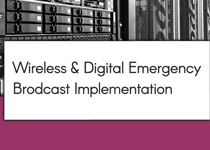Wireless and Digital Emergency Broadcast Implementation
Whitepaper Preview
In 21st century we have been witnessing accelerating climate change, natural disasters, war conflicts, pandemics, economic turbulences and resource shortages that endanger the livelihood of ever-growing number of people. In such a challenging environment, populations around the world became more vulnerable. Acknowledging this new reality, governments are looking for a more efficient and new type of Public Warning Systems (PWS). Today many countries rely on legacy systems like sirens, public signage and local media, which are often ill-adapted and ineffective to the specifics of the modern crises and the public is often fed with outdated information. To address these shortcomings, it is essential for governments to implement faster and geo-targeted public alerts delivery using a new generation of wireless and digital network technologies.
How can governments introduce new generation PWS and use them effectively in synergy with other parties while also enhancing existing and conventional systems?
What mass communication digital/wireless channels do governments have? What channels are mostly used and have the highest efficiency? See examples of how governments use early warning technologies like cell broadcast (Cell Broadcast Center + Cell Broadcast Entity), SMS and others? Download our whitepaper and find the answers.
Please also check our whitepaper about the use of cell broadcast as an emergency alert channel during COVID-19.












